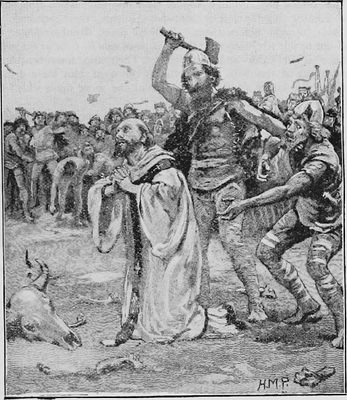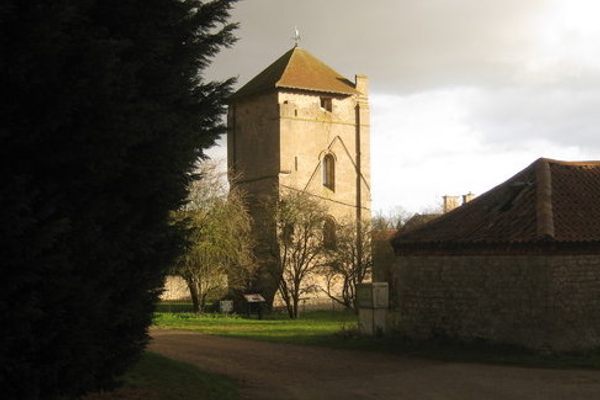About
Among the many vibrantly colored stained-glass windows of Canterbury Cathedral are three medieval-era panes that are among the oldest still intact. They tell the tale of the bloody Viking siege of Canterbury in 1011, and the kidnap and murder of the archbishop at the time, Alphege, or "Ælfheah" as he was known in Anglo-Saxon days.
In the 11th century, the kingdoms of England were plagued by constant raids by marauding Vikings from Denmark. The Danes attacked villages, towns, and cities throughout the country, burning and pillaging settlements and massacring the inhabitants. The climate of fear spread by these attacks was such that people believed a biblical apocalypse was nigh and interpreted the raids as the wrath of god brought upon them.
The Vikings were merciless in their conquests, but they could, on occasion, be tempted with financial incentives to halt their attacks on cities, and so a taxation system emerged in England and France that became known as "the Danegeld." The system worked rather like the protection rackets of the Mafia, with kingdoms and cities paying a "tribute" of tonnes of silver coins to an emissary of a Viking horde in order to buy their way out of being slaughtered.
Still, the stoking of Viking greed was a far from perfect means of securing long-term peace, and it could backfire with bloody consequences. Such a disastrous blowback was to occur in the year 1011 in Canterbury. Two years earlier, a Danegeld of 3,000 pounds of silver had been promptly paid by the people of Kent to a Viking army led by a fearsome warlord known as "Thorkell the Tall." The Vikings had landed at the coast nearby and were marching to attack Canterbury. The payment led to an agreement that the city would be spared, but Thorkell and his men simply turned their attention to other cities in the south and continued raiding across England.
But Thorkell returned to Canterbury, leading an even larger army. The horde launched an attack on the city, but its citizens had been warned of the approaching army and had prepared for war in advance. The Vikings, who had been expecting an easy victory, were therefore met by a ferocious Saxon counterattack that prevented them from breaching the walls. The situation became a siege that was to last a grueling three weeks, with constant battles leaving many dead on both sides.
Eventually, the Vikings managed to break through the defenses. They rampaged through the streets setting fire to the city buildings, vandalizing monuments, and butchering its citizens with spear, sword, and battle ax. When they reached the cathedral the pagan warriors set about murdering the monks and looting the valuable gold and silver objects.
The Archbishop Alphege was captured and taken hostage by the triumphant Thorkell, who left the ransacked city after burning the cathedral ruins. Alphege was taken to an encampment and kept in captivity for seven months while the Danes attempted to ransom him in exchange for gold and silver. The archbishop was unwilling to be ransomed, and the Vikings finally took him to a field where he was pelted with the bones of oxen they had feasted on.
Several of the Danes supposedly became so disgusted by this cruelty toward the archbishop they tried to stop it, and some even offered everything but their warships in return for Ælfheah's life. But the torment continued until one man stepped forward and put the stoic archbishop out of his misery with a swift blow from a battle ax. In the aftermath of the siege of Canterbury and the murder of Alphege, many Vikings, including Thorkell, defected to the side of the Saxons and converted to Christianity. Alphege was canonized as a saint for his martyrdom.
Few signs of this period of Canterbury's history remain except the beautiful Alphege windows, three circular panes of glass depicting the fate of St. Alphege during the brutal Viking siege of 1011. They were made during the 12th century, and are among the oldest stained-glass windows in Canterbury Cathedral.
Related Tags
Know Before You Go
Canterbury Cathedral is open from 9 a.m. to 5 p.m. on weekdays and Saturdays, and from 12:30 p.m. to 2:30 p.m. on Sundays. The entrance fee is £12.50. The Alphege windows are located high on the north side of the choir (quire) at the center of the cathedral.
If you want to see the windows it is best to come during the day and preferably on a summer day when the abundance of light makes the details visible. During winter the gloomy and overcast weather makes appreciating the colours of the windows almost impossible.
Published
January 29, 2019




























